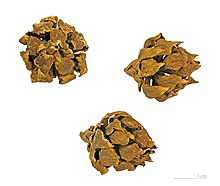Sickle-shaped scaly spruce
| Sickle-shaped scaly spruce | ||||||||||||
|---|---|---|---|---|---|---|---|---|---|---|---|---|

Sickle-shaped scaly spruce ( Athrotaxis selaginoides ) in Cradle Mountain Lake St. Clair National Park in Tasmania |
||||||||||||
| Systematics | ||||||||||||
|
||||||||||||
| Scientific name | ||||||||||||
| Athrotaxis selaginoides | ||||||||||||
| D. Don |
The athrotaxis selaginoides ( Athrotaxis selaginoides ) is a conifer of the genus of athrotaxis ( Athrotaxis ) in the family of cypress plants (Cupressaceae). The evergreen tree is native to Tasmania .
description
Athrotaxis selaginoides grows as an evergreen tree .
It forms a conical tree crown and reaches heights of up to 30 m with trunk diameters of up to 2 m. Often a large part of the trunk is knotless. In extreme locations, the species grows like a shrub crawling to the ground. The bark of the trunk is orange-red, slightly furrowed and peels off in long strips. The branches stand upright. The leaves are glossy green, 8–13 mm long and arranged in a spiral. They are widely protruding, very pointed with a curved tip and lanceolate. They are keeled on the underside with two small depressions and two bright blue and white ostomy bands. The leaves are entire.
The species is monoecious . The male cones sit at the end of short branches and contain two pollen sacs. The female cones sit on a 2–3 mm long stalk; they are spherical and 2.5 to 3 cm in size. The cones are initially orange and later turn brown; the scales are triangular, paper-like and pointed. There are 2–4 winged seeds per cover scale .
distribution
The species is endemic to Tasmania . It occurs in mountain regions of the central plateau at altitudes of 914 to 1219 m above sea level. NN in the western to central part of the island. Natural deposits that can be visited are located in the Cradle Mountain Lake St. Clair National Park .
The species is not hardy in Central Europe ; in the USDA climate zone system , it is only hardy up to climate zone 8.
use
Old tree specimens of the species are used for dendrochronological studies. A row of tree rings could be erected over 777 years.
Since the species is very slow-growing, intensive commercial use of the wood would extremely endanger the population. The wood is very light, with heartwood tinged pink to reddish brown and yellow sapwood. The soft wood has a fine grain with clearly recognizable growth rings and can be easily split; it is very durable. It is used, among other things, in boat building.
Systematics
The species was first described in 1838 by the British botanist David Don . A synonym is Athrotaxis alpina Van Houtte ex Gord. .
swell
- Christopher J. Earle: Athrotaxis selaginoides. In: The Gymnosperm Database. December 12, 2010, accessed October 20, 2011 .
- Athrotaxis selaginoides at Plants For A Future
Individual evidence
- ↑ David Don, in Ann. Nat. Hist. 1: 234. 1838.
Web links
- Distribution map at the Arboretum de Villardebelle
- Photos ( memento from January 25, 2004 in the Internet Archive ) at the Ruhr University Bochum
- Photo at the Australian National Botanic Gardens (English)
- Photos at utas.edu.au (English)
- Athrotaxis selaginoides in the endangered Red List species the IUCN 2009. Posted by: Conifer Specialist Group, 1998. Retrieved on 22 May, 2009.
- About the extracted from the leaves of essential oil (English)
- Photos of twig and cones, Bochum Botanical Association
